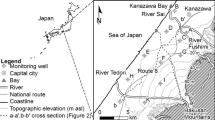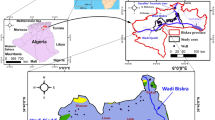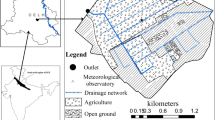Abstract
Accurate estimation of irrigation return flow plays an important role in the effective management of groundwater, especially in arid and semiarid irrigation regions. However, there is a lack of sufficient research to clarify hydrological process dynamics associated with irrigation return flow. In this study, first, a two-dimensional/three-dimensional model, HYDRUS-2D/3D, was adopted to analyze two different irrigation types in the Delingha Depression, which is located at the northeastern margin of the Qaidam Basin, China. Then, a 3D saturated flow model was established. This study determined the effect of agricultural water application on the dynamics of irrigation return flow. A large difference in the irrigation return-flow coefficient (IRFC) was seen during the growing season; an IRFC of 0.3 was obtained using flood irrigation, whereas ditch irrigation resulted in an IRFC of only 0.1. The lag time of recharge was approximately 150 days. It was necessary to consider the lag time for the 3D numerical model to obtain satisfactory results. Flood irrigation led to a groundwater recharge rate of 90 mm/year. These results indicate that the lag time should be considered when groundwater recharge is estimated or modeled.
Résumé
Une estimation précise de l’écoulement restitué à l’aquifère lié à l’irrigation joue un rôle important dans la gestion efficace de l’eau souterraine, en particulier dans les régions d’irrigation arides et semi arides. Pourtant, on manque d’une recherche suffisante pour élucider la dynamique du processus hydrologique associé à cet écoulement restitué à l’aquifère lié à l’irrigation. Dans la présente étude, un modèle bidimensionnel/tridimensionnel, HYDRUS 2D/3D, a été choisi dans le but d’analyser deux modalités différentes d’irrigation dans la Dépression de Delingha, située à la bordure nord-est du Bassin du Qaidam en Chine. Ensuite, un modèle d’écoulement saturé a été établi. Cette étude a déterminé l’incidence de la demande en eau de l’agriculture sur la dynamique de l’écoulement restitué à l’aquifère lié à l’irrigation. Une différence importante de la valeur du coefficient de l’écoulement restitué à l’aquifère lié à l’irrigation (CERI) a été observée au cours de la saison de croissance; un CERI de 0.3 a été obtenu pour une irrigation par inondation, tandis que l’irrigation par canaux s’est traduite par un CERI de 0.1 seulement. Le temps de retard de la recharge était environ de 150 jours. Il a été nécessaire de prendre en considération le temps de retard dans le modèle numérique 3D pour obtenir des résultats satisfaisants. L’irrigation par inondation a conduit à une recharge des eaux souterraines de 90 mm/an. Ces résultats indiquent que le temps de retard devrait être pris en compte lorsqu’on évalue ou modélise la recharge des eaux souterraines.
Resumen
La estimación correcta del caudal de retorno del riego desempeña un papel importante en la gestión eficaz de las aguas subterráneas, especialmente en las regiones áridas y semiáridas con riego. Sin embargo, no hay suficientes investigaciones para aclarar la dinámica de los procesos hidrológicos relacionados con el flujo de retorno del riego. En este estudio, en primer lugar, se adoptó un modelo bidimensional/tridimensional, HYDRUS-2D/3D, para analizar dos tipos de riego diferentes en la depresión de Delingha, que está situada en el margen nororiental de la cuenca de Qaidam (China). Luego, se estableció un modelo tridimensional de flujo saturado. Este estudio determinó el efecto de la aplicación de agua destinada a la agricultura en la dinámica del flujo de retorno de la irrigación. Se observó una gran diferencia en el coeficiente de retorno del flujo de riego (IRFC) durante la temporada de cultivo; se obtuvo un IRFC de 0.3 utilizando el riego por inundación, mientras que el riego por zanjas dio como resultado un IRFC de sólo 0.1. El tiempo de retardo de la recarga fue de aproximadamente 150 días. Fue necesario considerar el tiempo de retardo para que el modelo numérico tridimensional obtuviera resultados satisfactorios. El riego por inundación dio lugar a una tasa de recarga de las aguas subterráneas de 90 mm/año. Estos resultados indican que el tiempo de retardo debe considerarse cuando se estima o modela la recarga de las aguas subterráneas.
摘要
准确估算灌溉回归量在有效管理地下水方面起着重要作用, 尤其是在干旱和半干旱的灌区。但是, 缺乏足够的研究来阐明与灌溉回归相关的水动力学过程。在这项研究中, 首先, 我们使用二维/三维模型(HYDRUS-2D/3D)来分析位于柴达木盆地东北边缘的德令哈坳陷的两种不同灌溉类型。然后建立了3D饱和流模型。这项研究确定了农业用水对灌溉回归动态的影响。在生长期, 灌溉回归系数(IRFC)差异很大。使用洪水灌溉的IRFC为0.3, 而使用沟渠灌溉的IRFC只有0.1。补给的滞后时间约为150天。为了获得令人满意的结果, 有必要考虑三维数值模型的滞后时间。洪水灌溉产生的地下水补给率达到90 mm/year。这些结果表明, 在估算或建模地下水补给量时应考虑滞后时间。
Resumo
A estimativa precisa do fluxo de retorno da irrigação desempenha um papel importante no gerenciamento eficaz da água subterrânea, especialmente em regiões de irrigação áridas e semiáridas. No entanto, há uma falta de pesquisas suficientes para esclarecer a dinâmica do processo hidrológico associado ao fluxo de retorno da irrigação. Neste estudo, primeiramente, um modelo bidimensional/tridimensional, HYDRUS-2D/3D, foi adotado para analisar dois tipos diferentes de irrigação na Depressão de Delingha, que está localizada na margem nordeste da Bacia Qaidam, na China. Em seguida, um modelo de fluxo saturado 3D foi estabelecido. Este estudo determinou o efeito da aplicação de água na agricultura na dinâmica do fluxo de retorno da irrigação. Uma grande diferença no coeficiente de retorno-fluxo de irrigação (CRFI) foi observada durante a estação de crescimento; um CRFI de 0.3 foi obtido usando irrigação por inundação, enquanto a irrigação por valas resultou em um CRFI de apenas 0.1. O tempo de atraso para recarga foi de aproximadamente 150 dias. Foi necessário considerar o tempo de atraso do modelo numérico 3D para obter resultados satisfatórios. A irrigação por inundação levou a uma taxa de recarga das águas subterrâneas de 90 mm/ano. Esses resultados indicam que o tempo de atraso deve ser considerado quando a recarga da água subterrânea é estimada ou modelada.












Similar content being viewed by others
References
Achraf M, Abdollahi K, Fatahi R, Abida H (2017) Groundwater recharge estimation under semi arid climate: case of northern Gasfsa watershed, Tunisia. J Afr Earth Sci 04(20):37–46
Anuraga TS, Ruiz L, Kumar MSM, Sekhar M, Leijnse A (2006) Estimating groundwater recharge using land use and soil data: a case study in South India. Agric Water Manag 84(1–2):65–76
Awan UK, Ismaeel A (2014) A new technique to map groundwater recharge in irrigated areas using a SWAT model under changing climate. J Hydrol 519:1368–1382
Cheng C, Chen X (2007) Evaluation of methods for determination of hydraulic properties in an aquifer–aquitard system hydrologically connected to a river. Hydrogeol J 15(4):669–678
Crosa G, Froebrich J, Kayumov O (2002) Development of integrated water management tools for the Tuyamun reservoir complex (IMWT). In Proceedings of the Conference on Sustainability of Aquatic Ecosystems, pp. 26–28.
Deng L, Wang W, Hu A (2011) Estimation of groundwater recharge by chloride mass balance (CMB) method in a typical semiarid climate of China. International Symposium on Water Resource and Environmental Protection, Xi’an, China, May 2011, pp 400–403. https://doi.org/10.1109/ISWREP.2011.5893029
Dewandel B, Gandolfi J.‐M., Condappa D. de, Therrien R, Ahmed S (2008) An efficient methodology for estimating irrigation return flow coefficients of irrigated crops at watershed and seasonal scale , Hydrological Processes 22:1700–1712.https://doi.org/10.1002/hyp.6738
Feddes RA (1978) Simulation of field water use and crop yield, Soil Science 129(3):193
Healy RW, Cook PG (2002) Using groundwater levels to estimate recharge. Hydrogeol J 10:91–109
Huo S, Jin M (2015) Effects of precipitation and irrigation on vertical groundwater recharge. Hydrogeol Eng Geol 42(5):6–21
Hu Q, Yang Y, Han S, Yang Y, Ai Z, Wang J, Ma F (2017) Identifying changes in irrigation return flow with gradually intensified water-saving technology using HYDRUS for regional water resources management. Agricultural Water Management 194:33–47
Jafari H, Raeisi E, Zare M, Haghihi AAK (2012) Time series analysis of irrigation return flow in a semi-arid agricultural region, Iran. Archives Agron Soil Sci 58(6):673–689
Jiménez-Martínez J, Skaggs TH, Van Genuchten MT, Candela L (2009) A root zone modelling approach to estimating groundwater recharge from irrigated areas. Journal of Hydrology 367(1-2):138–149
Kendy E, Zhang Y, Liu C, Wang J, Steenhuis T (2004) Groundwater recharge from irrigated cropland in the North China plain: case study of Luancheng County, Hebei Province, 1949–2000. Hydrol Process 18(12):2289–2302
Lecina S, Isidoro D, Playán E, Aragüés R, Ahmed S (2010) Irrigation modernization and water conservation in Spain: The case of Riegos del Alto Aragón, Agricultural Water Management 97(10):1663–1675. https://doi.org/10.1016/j.agwat.2010.05.023
Li X, Fan Z, Ji F (1999) The characteristics of water transformation and its effects to environment in Xinjiang—a case study at Alar irrigation area. Arid Land Geogr 22(2):1
Lu X, Jin M, van Genuchten MT, Wang B (2011) Groundwater recharge at five representative sites in the Hebei Plain, China. Groundwater, 49(2):286–294
McMahon PB, Dennehy KF, Bruce BW, Bohlke JK, Michel RL, Gurdak JJ, Hurlbut DB (2006) Storage and transit time of chemicals in thick unsaturated zones under rangeland and irrigated cropland, High Plains, United States. Water Resour Res 42:W03413. https://doi.org/10.1029/2005WR004417
Mohan C, Wei Y, Saft M (2018) Predicting groundwater recharge for varying land cover and climate conditions: a global meta-study. Hydrol Earth Syst Sci 22(5):2689–2703
Ouyang W, Huang H, Zhang X, Hao F, Wang X, Duan H, Guo B (2015) Simulation of water balance in Hetao Irrigation District using SWAT model. J Irrig Drain 34(1):17–22
Pekel JF, Cottam A, Gorelick N, Belward AS (2016) High-resolution mapping of global surface water and its long-term changes. Nature 540(7633):418–422
Poch-Massegú R, Jiménez-Martínez J, Wallis KJ, de Cartagena FR, Candela L (2014) Irrigation return flow and nitrate leaching under different crops and irrigation methods in Western Mediterranean weather conditions. Agricultural Water Management, 134:1–13
Rodell M, Velicogna I, Famiglietti JS (2009) Satellite-based estimates of groundwater depletion in India. Nature 460(7258):999
Scanlon BR, Reedy RC, Gates JB, Gowda PH (2010) Impact of agroecosystems on groundwater resources in the central high plains, usa, Agriculture Ecosystems & Environment 139(4):700–713
Scott CA, Vicuan S, Blanco-Gutiérrez I, Meza F, Varela-Ortega C (2014) Irrigation efficiency and water-policy implications for river basin resilience, Hydrology and Earth System ences Discussions 18(18):1339–1348
Siebert S, Doll P, Hoogeveen J, Faures JM, Frenken K, Feick S (2005) Development and validation of the global map of irrigation areas. Hydrol Earth Syst Sci 9(5):535–547. https://doi.org/10.5194/hess-9-535-2005
Simons GWH, Bastiaanssen WGM, Immerzeel WW (2015) Water reuse in river basins with multiple users: a literature review. J Hydrol 522:558–571
Šimůnek J, van Genuchten MT, Šejna M (2016) Recent developments and applications of the HYDRUS computer software packages. Vadose Zone J 15:7, 25 pp. https://doi.org/10.2136/vzj2016.04.0033
Skaggs TH, Trout TJ, Šimůnek J, Shouse PJ (2004) Comparison of HYDRUS-2D simulations of drip irrigation with experimental observations. J Irrig Drain Eng 130(4):304–310
Su YM (2018) The groundwater numerical simulation of the Quaternary strata in Delingha area in Qaidam Basin (in Chinese). MSc Thesis, China University of Geosciences Beijing, Beijing, China
Szymkiewicz A, Gumuła-Kawęcka A, Šimůnek J et al (2018) Simulations of freshwater lens recharge and salt/freshwater interfaces using the HYDRUS and SWI2 packages for MODFLOW. J Hydrol Hydromech 66(2):246–256
Tilahun K, Merkel BJ (2009) Estimation of groundwater recharge using a GIS-based distributed water balance model in Dire Dawa, Ethiopia. Hydrogeol J 17(6):1443–1457
Wen G (2018) Groundwater hydrological processes and its ecological effects in Bayin River Basin, PhD Thesis, Chang’an University, China
Yeh PJ, Eltahir EA (2005) Representation of water table dynamics in a land surface scheme. Part I: Model development. Journal of climate 18(12):1861–1880
Zhan Y, Yanfang L, Weiling Z, Shicai D (2016) Spatial distribution characteristics of root system of Lycium barbarum L. in Hexi Irrigation area (in Chinese). Res Soil Water Conserv 23:133–137.https://doi.org/10.13869/j.cnki.rswc.2016.04.017
Zhang XY, Pei D, Chen SY (2004) Root growth and soil water utilization of winter wheat in the North China plain. Hydrol Process 18(12):2275–2287. https://doi.org/10.1002/hyp.5533
Zhang Z, Yang S, Shi H, Ma J, Zhang W (2011) Irrigation infiltration and recharge coefficient in Hetao Irrigation District in Inner Mongolia. Trans Chinese Soc Agric Eng 27(3):61–66
Funding
This study was supported by the National Natural Science Foundation of China (No. U1603243, 41230314, 41902249) and the Shaanxi Science and Technology Research and Development Project (2014 K15-01-02).
Author information
Authors and Affiliations
Corresponding author
Additional information
Publisher’s note
Springer Nature remains neutral with regard to jurisdictional claims in published maps and institutional affiliations.
This article is part of the topical collection “Groundwater recharge and discharge in arid and semi-arid areas of China”
Rights and permissions
About this article
Cite this article
Wang, W., Zhao, J. & Duan, L. Simulation of irrigation-induced groundwater recharge in an arid area of China. Hydrogeol J 29, 525–540 (2021). https://doi.org/10.1007/s10040-020-02270-3
Received:
Accepted:
Published:
Issue Date:
DOI: https://doi.org/10.1007/s10040-020-02270-3




